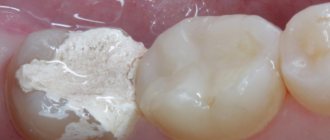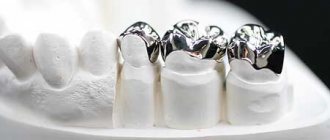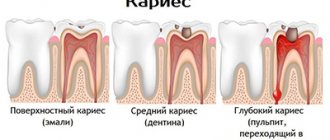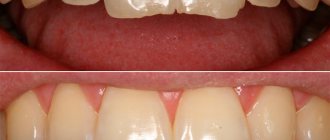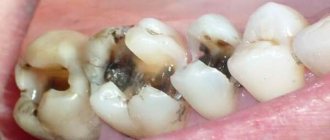Even small children know what a dental filling is. Filling material is used to fill cavities formed after treatment of carious lesions or due to traumatic exposure. Knowing the characteristics of a particular type, you can select the most suitable compositions that can accurately imitate healthy tissue and last for many years.
The installation process is quite complex and requires professionalism and accuracy from the doctor. If you make a mistake at one of the stages, all manipulations may be useless.
What is a filling?
Millions of people get rid of carious lesions without resorting to tooth extraction, thanks to the hardening filling mass used in dentistry. It consists of different chemicals with their own characteristics, advantages and disadvantages. The main goal of treatment is to restore the integrity of the teeth, restore full chewing function and prevent the penetration of pathogenic microorganisms into damaged tissues.
Installing tabs is not always advisable. With extensive lesions, more labor-intensive and lengthy recovery is required with the help of bridges or implants.
Temporary and permanent fillings
The division into these types is made according to their intended purpose. The first type of product (diagnostic) is used to isolate a unit for a certain period; a medicinal product with medicinal additives is previously applied under the filling material.
The doctor also decides on installation if he suspects that the patient may develop pulpitis. The filling is created from low-strength compounds that do not have a long service life. Thanks to this feature, the dentist can easily remove the filling material from the cavity. In most cases, synthetic dentin is used in manufacturing. After drilling with a drill, it helps to isolate the voids into which arsenic is placed to kill the nerves.
Installing permanent products is more difficult and takes longer. They must last long enough, so they are made from durable and wear-resistant compounds. The installation consists of several sequential steps that should not be neglected. Filling material helps to provide:
- tight sealing of holes formed during treatment;
- protection against penetration of pathogenic microorganisms;
- complete restoration of chewing function;
- aesthetic appeal of the dentition.
How teeth are filled - stages of treatment
Installation of the seal is carried out in several stages. Although the entire treatment process can take place in one visit to the dentist. Stages of therapy:
- Diagnosis, anesthesia - according to indications.
Establishing diagnosis
- Removal of destroyed tissue, assessment of the condition of the pulp.
Removal of destroyed tissue
- According to indications, opening of the pulp chamber and removal of the dental nerve.
Removal of dental nerve
- Treatment of canals, filling them.
Canal treatment
- When treating extensive pulpitis, it is possible to install medications under a temporary filling.
- After the inflammatory process has stopped, a permanent filling is installed. Polymer materials are used for this. They are introduced into the cavity and harden under the influence of a UV lamp. At the end of the procedure, the filling is polished.
Installation of a permanent filling
No specialized preparation for filling is required. The procedure is carried out either as planned or urgently if pain or tissue swelling develops on the day of visiting the doctor. Before going to the clinic, it is recommended to remove any remaining food from the mouth and brush (as far as possible) your teeth.
What you should pay attention to when choosing fillings
In order for the filling to be successful and the result to last for a long time, it is necessary to take a responsible approach to selecting the appropriate type of product. Many patients are confused when they learn how many varieties there are. What criteria should be taken into account when choosing a filling material:
- strength and wear resistance;
- environmental friendliness;
- safety for the body;
- hardening in minimal time;
- tightness, flexibility when grinding;
- maintaining the original shade throughout its service life.
In addition, the manufacturer plays an important role. Professional doctors prefer Israeli, German and other European brands because they produce high-quality products that are absolutely safe and meet other requirements. Such accessories last a long time, they are reliable and strong. A negative point is the higher price compared to domestic analogues, but for many this will not seem like a minus.
How to place a filling on a front tooth - treatment details
Symptoms and methods of treating caries on the front teeth are similar to those used in the treatment of molars and premolars. But the doctor’s task is not only to eliminate the destruction of the incisors, but also to make the smile aesthetic.
Features of treatment of anterior teeth:
- choice of material - it should not become visible or differ in color from the incisor enamel;
- scrupulousness when working - the tooth should not darken;
- use ceramic filling materials.
The load on this incisor does not decrease, and after filling it becomes fragile. Therefore, the installation of ceramic crowns is recommended.
What to do with a wisdom tooth
The treatment method is chosen by the doctor after examining the patient. As a rule, they are not sealed and the canals are not cleaned. They do not bear the chewing load, so the dentist will suggest removing such a tooth.
Wisdom tooth
What are the types of dental fillings in dentistry, their advantages and disadvantages
There are many types of filling materials that are used to restore incisors, canines and molars. Products are made from cement, plastic, ceramics, amalgam, light polymer and chemically cured composites. They all differ in durability, strength, aesthetics, cost and installation method. To make the right choice, you need to know the features of each type, their positive and negative sides.
Cement
The composition contains a powdery substance and liquid concentrated acid. When they react, a paste is formed that hardens in a short time. You can use a mass based on phosphates or silicates.
Pros:
- low price;
- to restore the crown, you do not need any special tools;
- The procedure itself takes little time; a dentist can handle this even without extensive experience.
There are quite a lot of disadvantages:
- inability to maintain its original shape for a long time;
- long hardening;
- instability to external influences, as a result of which the original integrity is quickly lost;
- high risk of new carious lesions;
- if installed incorrectly, dental tissue may be damaged;
- toxic composition with poor biological compatibility with the human body.
Despite the wide list of disadvantages, cement is very popular. Patients prefer the material due to its availability.
Plastic
Most often they are created on the basis of acrylic. Pros:
- low price;
- harden very quickly;
- durable, can last a long time;
- it is possible to choose a color that is as close as possible to the shade of natural enamel, so the changes that have occurred will not be noticeable to others.
The disadvantages are quite serious. Doctors recommend thinking about what other types of dental fillings there are before choosing this option. Negative sides:
- rapid deformation;
- change in original tone, staining with food, drinks, tobacco smoke;
- food particles often accumulate on surfaces;
- toxic mass, which is why relapses of caries are likely;
- If pulp removal was not carried out, after filling the risk of developing pulpitis increases significantly.
Amalgam
Metal is used very rarely for fillings. This is due to poor aesthetic properties, insufficient adhesion to the crown, and high thermal conductivity. It is difficult to give the product the required shape, and the material is toxic.
However, there is a significant plus. Amalgam is durable and lasts for a very long time in the treated cavity.
Ceramic
Teeth filled with ceramics look attractive; this is the most aesthetic option of all. Their main feature is the need for manufacturing in laboratory conditions. Dental technicians create fillings according to the patient’s individual parameters. Advantages:
- resistance to temperature changes and external mechanical influences;
- durability and high strength;
- preservation of the original appearance (color, shape) throughout the entire period of wearing.
Despite the obvious advantages, such products are installed much less frequently than others. This is due to the high price and long production time according to exact measurements.
Photopolymer (light-curing)
The most popular filling method. The question that every dentist asks during treatment is which filling to put on the tooth, gel or light.
The wide popularity of this option is due to the excellent ratio of quality and cost of installation. The product is practical, beautiful and durable. The composition becomes solid when it is exposed to ultraviolet light using a special lamp.
Main advantages:
- aesthetic appeal;
- plasticity, which simplifies the doctor’s work;
- good adhesion to healthy dental surfaces;
- easy to polish, giving the desired shape;
- no toxicity;
- affordable price.
These fillings also have disadvantages. For example, they cannot be placed in hard-to-reach areas. They cannot be used to temporarily seal cavities.
Glass ionomer
The mass contains a large amount of fluorine. Thanks to this feature, the likelihood of developing recurrent caries is reduced to zero. They are most often used in pediatric dentistry (you can see in the photo what a permanent filling on a child’s tooth looks like). Harden on their own or under the influence of ultraviolet rays.
Pros:
- good adhesion to surface tissues;
- eliminates the risk of secondary carious lesions;
- biologically compatible with the human body;
- identical to dentin fibers;
- easy to install;
- become hard even in conditions of high humidity;
- minimal shrinkage;
- aesthetic appeal;
- affordable price.
Minuses:
- deform if the conditions of solidification have been violated;
- complete hardening is possible only after a day;
- the likelihood of inflammatory processes occurring in the pulp if the doctor filled a very deep cavity and did not use a gasket;
- low strength;
- the inability to accurately reproduce the anatomical shape of a dental unit;
- short service life.
It is not always possible to choose the color of a filling material that matches the natural shade of enamel. Despite the negative aspects, doctors believe that this is a worthy alternative.
Interesting things about tooth fillings: briefly about the important things
How to distinguish a good filling from a bad one is probably a question that every person who has experienced certain problems with their teeth has asked at least once in their life. Today we will talk about fillings again and tell you a lot of interesting things: the purpose of this article is to share useful information and do it in a simple, interesting and understandable form!
Dental filling: how does the meeting with the dentist happen?
You felt a toothache, carefully examined the tooth with a mirror and came to a simple conclusion - caries. What do most people do in this case, trying to solve the problem? Absolutely right: they pick up the phone and start calling Kirov dentists, asking how much one ordinary filling will cost.
At the same time, the patient rarely cares about what material it is made of, for what dental problems it is optimal and how applicable it is in a particular case.
As a rule, the only concern is the price. And where this figure is lower, the Kirov resident goes there: they say, why pay more, because all the fillings are the same? In fact, the issue requires deeper analysis and consideration, which we will do right now.
Express dental treatment in Kirov or how long does it take to install a filling?
The first step is to answer the question, how long does it take to install a high-quality filling? Some clinics today offer an express filling service lasting 20-30 minutes. Let's be honest, it is unlikely that it will be possible to do high-quality work with an eye to a long-lasting effect during this time.
On average, installation of a simple filling, even the smallest one, takes 40-50 minutes. And often this time can reach 2-2.5 hours.
The thing is that the list of operations necessary for high-quality treatment of caries in Kirov is quite noticeable:
- Administration of anesthesia, including the time required for the freezing to take effect;
- Elimination of all carious and damaged tissues of the tooth being restored. And here it is very important to do this work as efficiently as possible, since flaws and mistakes can cost the patient dearly in the future - the filling may fall out, and pulpitis may develop in its place;
- Restoring tooth architecture is a process no less important and responsible than the previous one. Here it is important to take into account dozens of factors, including keeping the operated area completely dry, matching the color and shade, forming a competent architecture (so that the tooth chews well and does not interfere with its neighbors), as well as compliance with the technological process so that the filling hardens exactly as intended its manufacturer;
Polishing the filling, checking the bite, as well as a number of other important and irreplaceable procedures.
Thus, it becomes clear that caries treatment in Kirov cannot take 20 minutes: a high-quality solution to the problem requires more time.
And this is not all that the dentist takes into account during dental treatment - next we will look at a number of important requirements for fillings, which, unfortunately, not everyone observes.
Fighting moisture
It is known that a filling cannot serve faithfully for several years if mistakes were made during its installation. One of these mistakes is increased humidity in the operated area. Simply put, the place where the filling is installed must be absolutely dry - how do modern doctors solve this problem? One possible way is to use cotton swabs, which are placed between the gum and cheek so that saliva gets there. However, this does not provide an absolute guarantee of results, since moisture can still penetrate under the filling during its installation, which will cause it to fall out.
Today there is an excellent alternative, which is called dental treatment with a rubber dam in Kirov.
It is the use of this rubberized material that guarantees absolute protection against moisture penetration and, as a result, high quality sealing. However, we will not consider this issue in detail, since a full-fledged article on the website of Dr. Efremov’s Dentistry is devoted to rubber dam.
Guaranteed complete removal of caries
Now let’s return to the process of eliminating the affected tissue using a drill - by drilling out the dentin, the dentist removes the carious tissue so that a full-fledged filling appears in its place. And here an important question arises - how does the doctor understand that all the problematic substance has been removed and no more drilling is required?
Previously, all this was done “by eye”; today, caries detectors are used, which change their color when caries is detected in the cavity.
Special bur attachments are also quite applicable - they drill out only carious tissue, leaving healthy dentin - this is another effective way to work only with problematic material.
Some dentists prefer to drill out more tooth structure to get rid of the affected dentin “for sure.”
However, we are not supporters of this approach, striving to preserve as much of the patient’s own tooth volume as possible. It is also worth noting that all dental manipulations during the treatment of caries in Dr. Efremov’s Dentistry are carried out under magnification thanks to the participation of a Carl Zeiss OPMI Pico Mora operating microscope. This greatly improves the quality of treatment!
Restoration of the chewing surface
A few words about the process of restoring the architecture of the tooth: special attention must be paid to the chewing surface, through which the tooth will come into contact with food. Here it is also important to pay attention to the individual qualities of the patient:
- Features of the bite: the tooth must ensure a tight closure of the jaws, without interfering with the chewing process;
- The size of the filling determines the load on its base when chewing food - this is also an important point, neglect of which can lead to serious consequences;
- Tooth polishing should also be carried out with the utmost quality, because any discomfort in the oral cavity can cause thinning and even damage to the oral mucosa.
Operating with his professional instrument, the dentist works with the filling like an experienced sculptor, achieving the optimal result!
conclusions
We considered all these processes for a reason: surely now you have changed your attitude to the answer to the question, how much does a high-quality filling cost? The fact is that a filling is not only a material necessary to restore the architecture of a tooth after drilling. There are dozens of other important factors that affect the technological process and, of course, the quality of the result!
That is why the next time the question arises, “how much does a filling cost?”, try to expand your areas of interest by clarifying other equally important details. For example, is a rubber dam used in treatment, how is the completeness of work with the affected tissue determined, and what guarantee is given for fillings? Otherwise, a wise saying may come to the fore: the miser pays twice.
It is quite possible that you can find a dentistry where caries is treated for 1,500 rubles, however, this filling may only last for 1 year with subsequent replacement. In more expensive dentistry, prices are slightly higher, however, such fillings will last up to 10 years. You can draw your own conclusions!
We invite you to Doctor Efremov’s Dentistry: sign up for a consultation and get answers to all your questions! Information by phone: 8 (8332) 255-717 . Be healthy and take care of the beauty of your smile!
Installation of seals
Selecting the material is not enough; it is important to know about the installation features of the products. Durability and strength depend on the quality of work. Main stages:
- The doctor carefully examines the oral cavity, including using a mirror. If necessary, additional diagnostic tests (for example, x-rays) are prescribed. The dentist determines the extent of the damage and makes a final diagnosis.
- Local anesthesia is used. Doctors use anesthetic sprays or inject drugs.
- The dental unit is treated with special compounds, carious lesions are removed with a drill. The cavity and surface tissues are cleaned of small particles.
- Drying.
- If the deep layers of dentin are affected, a special pad with calcium is made. In this way, you can speed up the elimination of the inflammatory process, if any.
- An insulating cushioning material consisting of components with an increased level of adhesion is applied.
- The filling itself is installed directly.
- If a light-curing base is installed, each layer must be illuminated with a special apparatus.
At the final stage, everything is polished and adjusted to the natural bite. The doctor gives recommendations on proper care and use.
Dentists: therapist, surgeon, orthopedist, orthodontist
The profession of dentist combines several different areas connected by a common field of activity. Depending on their specialization, dentists are divided into therapists, surgeons, orthopedists and orthodontists.
Dentist-therapist
The therapist treats the most common dental disease - caries. Cleaning dental canals, removing diseased nerves, and filling are also within his competence.
A dental therapist can also restore teeth using filling materials to save a tooth that has begun to decay. Much in this case depends on the quality of materials and the skill of the doctor.
Dental surgeon
In advanced cases, damaged teeth have to be removed. This is what a dental surgeon does. He also cleans out cavities between teeth and gums due to periodontal disease (the scientific name for this process is curettage), removes cysts, and performs bone grafting.
A dental surgeon performs operations on the jaws, joints and face associated with injuries, congenital and acquired defects, tumors, infectious and inflammatory processes, diseases of the salivary glands and nerve fibers located in this area.
The implantation of implants (artificial roots) into the jaw bone for further prosthetics is also within the competence of the surgeon.
Often, doctors of this profile have to remove so-called sunken wisdom teeth, which grow in the wrong direction and cause inflammation and severe pain in the gums.
Orthopedic dentist
Otherwise, this specialist is called a prosthetist. He selects the appropriate prosthetic option for the patient and takes impressions of the teeth. The orthopedist tries on, adjusts the dentures and secures them in the patient’s mouth.
Today, such prosthetic options are possible as fixed (crowns, inlays, bridges), removable and conditionally removable (the prosthesis can be easily removed by a doctor, but the patient himself cannot remove it), as well as implantation. Implantation allows you to completely restore the appearance of a lost tooth and its functioning.
Dentist-orthodontist
An orthodontist deals with dental correction: corrects the bite if teeth grow unevenly. For this, braces or special mouth guards are used to gradually move the teeth in the right direction. Orthodontics not only makes your smile beautiful, but also helps prevent tooth decay and gum disease.
Post new comment
About Us
Our partners
Sections
VitaPortal - website about health
We provide information under the following main sections.
- News of health, nutrition, diets and healthy lifestyles
- Proper nutrition, weight loss, diets
- Allergies and new treatments
- Bad habits and ways to give them up
- Human diseases, diagnostic and treatment methods
- Having and raising children
- Sports and fitness
- Healthy food recipes
- Free consultations with doctors
- Blogs of doctors, nutrition and fitness experts, interest groups
- Online appointment service with a doctor EMIAS
Your health is our goal
"VitaPortal" occupies one of the first places among the official medical sites in RuNet in terms of the number of users. For many of them, we have become their favorite medical site, and we strive to justify their trust by constantly updating and updating information about human health. Our mission is to create more healthy people. And providing verified information is our way to achieve our goal. After all, the more informed our user is, the more careful he will be with his main asset - health.
The VitaPortal team includes certified doctors and experts in their fields, candidates and doctors of medical sciences, health journalists
VitaPortal is an official medical website dedicated to human health. Our main goal is to provide the user with verified information verified by experts in their fields.
Our health website was created not for medical practitioners, but for ordinary users. All information is adapted and presented in accessible and understandable language, medical terms are deciphered. At the same time, we pay great attention to verifying the authenticity of our sources, which are only official medical websites, scientific medical journals and practicing doctors and experts.
Recommendations and opinions published on the Site, including materials on the SlimSmile personal diet, ARE NOT A SUBSTITUTE FOR QUALIFIED MEDICAL CARE. Be sure to consult your doctor.
Information materials posted on the site, including articles, may contain information intended for users over 18 years of age in accordance with Federal Law No. 436-FZ of December 29, 2010 “On the protection of children from information harmful to their health and development.”
©2011- VitaPortal, all rights reserved. Certificate of registration of mass media El No. FS77-45631 dated June 29, 2011. VitaPortal does not provide medical consultations or diagnoses. Detailed information.
How much does treatment cost?
The amount depends on the material. For example:
- Conventional composites without installing gaskets cost about 3 thousand rubles.
- Glass ionomer cement will cost more, 4000.
- Ceramic inlay excluding work performed - 3500.
- Metal can be supplied cheaply, for 1,500 rubles.
It is more accessible to treat children. This is due to the speed of the process, which takes place much faster. On average, parents pay about 2 thousand. Old elements are removed for 700 rubles; setting up a diagnostic design, as a rule, does not exceed 1000.
It is not recommended to save on filling products, especially when it comes to deep lesions of dentin tissue. The patient will be able to forget about dental problems for a long time and will not experience any inconvenience.
What does the cost depend on?
The final price consists of many factors that are taken into account by the clinic’s specialists when making calculations. As a rule, the following points are important:
- materials used;
- use of expensive equipment;
- size of the affected area;
- number of dental visits;
- professional experience, qualification category of a doctor;
- location of the clinic.
Don't be surprised to see a tidy sum on the check. Achieving quality results can be difficult. Sometimes more than one visit to the dentist’s office is required, including the installation of a temporary structure and the placement of medication to kill the nerve.
Thus, the cost directly depends on the stages of treatment. Standard list of services:
- initial examination;
- cleaning affected areas;
- application of a medicinal product;
- anesthesia, local anesthetic;
- panoramic or spot shot;
- cleansing and formation of channels;
- filling;
- installation of a diagnostic or permanent product.
The price list can be found directly at the medical institution or on the website (usually such information is provided in detail).
Which dentist treats caries?
In dental practice, 3 specialists can fill teeth at once:
- Dentist;
- therapist;
- pediatric dentist.
The job description of the first professional includes a wide range of responsibilities. He chooses treatment tactics, administers anesthesia, diagnoses, prevents and treats caries. However, this specialization does not require lengthy training in higher education institutions.
Important! Today, the profession of a dentist is considered obsolete. Their main responsibilities are handled by junior medical staff. Therapists are responsible for diagnosis and treatment.
The pediatrician can also place fillings. However, its focus is the elimination of oral diseases in children.
The dentist-therapist is the first one who receives and examines the patient. This is a generalist. If only conservative intervention is required, it will be handled by a therapist. But when specific therapy is needed, he will refer you to another doctor: an orthodontist, a prosthetist, a surgeon, a periodontist.
Additional Information! A dentist of any specialization is familiar with all manipulations. Therefore, it is not always important which doctor puts the fillings. The procedure may be necessary when performing work of a different nature: prosthetics, orthodontic treatment and other manipulations.
Which fillings are best for front, side and chewing teeth?
When treating incisors and canines, increased aesthetic requirements are imposed. Common materials:
- silicate cement composition;
- light-curing composite elements;
- glass ionomers.
Molars are not visible to the naked eye when a person talks or smiles. During therapy, dentists use masses that, after hardening, are able to withstand maximum loads without deforming. These include:
- photopolymers;
- amalgam;
- ceramic;
- cement;
- two-component composites;
- glass ionomer.
Types of fillings
When visiting a dentist, your doctor may offer fillings made from various materials. The most common are the following:
- Cement. They have excellent strength, but do not differ in aesthetics.
- Composite. The most aesthetic option, but the strength leaves much to be desired.
- Light. The most popular fillings that harden by polymerization with a blue lamp.
- Plastic. Such fillings darken very quickly and are clearly not suitable for the restoration of front teeth.
Let's sum it up
There are many types of dental fillings for filling teeth, which differ in materials of manufacture, purpose and other criteria. The type of product is selected together with the attending physician. In this case, it is important to take into account the quality of adhesion to natural surfaces, aesthetic properties, hardening speed and other points. For many patients, the cost of installation is a deciding factor, so strength and durability take a back seat.
The price depends on many factors, for this reason it is important to carefully consider the choice of treatment method. Having figured out what types of permanent dental fillings there are (the names of the types are discussed above), you can forget about pain and other discomfort for a long time, enjoying a dazzling smile.
What is a light seal
It is no secret that Soviet dentistry was on the sidelines of world progress in its field of medicine. Today things are much better. If we talk about private dentistry, then everything is pretty good here (relative to the recent past).
State clinics that provide dental services have also updated their material and technical base. Despite this, you can often find “dinosaur doctors” there who, “at their age,” no longer want to learn new modern techniques and treat the old-fashioned way.
And the system of state dental clinics itself has not gone far, if we talk about the standards of services provided. Well, for example, in our country, canals are still treated with arsenic (it’s poison, if anything), and light-curing filling remains a VIP service =).
Remember! In modern adult dentistry, arsenic is not used, and only light-cured fillings are used!
A light-curing filling or photopolymer filling is a plastic material, the hardening of which occurs under the influence of a special polymerization lamp.
Even the simplest light filling has a tremendous advantage over a conventional filling (chemical curing). Among the advantages are: better fit (read to the end why this is needed), resistance to abrasion, and the ability to accurately adjust the shape of the tooth being restored, as a result - turnkey work in one visit.
Important! The key to a good and durable filling is not only the material, but also the quality of the treatment performed!
Yes, you can put a filling made of the most expensive material, but treat the tooth in such a way that within a year the tooth will have to be removed (this is, of course, necessary to try, but it happens).
What is implantation
People who have not previously encountered implantation have somewhat generalized information about this dental procedure. The installation of implants is often mistakenly mistaken for prosthetics. However, these are mini-operations, despite the similar goals, dental restoration is a completely different procedure.
Implantation is a dental operation to insert a pin or, as they are correctly called, an implant into the jaw tissue (in place of a missing tooth). In the future, the pin will replace the root, on which a structure will be installed to replace the tooth.
The operation has many features, one of which is the absence of the need for your own bone and jaw tissue. Unlike prosthetics, this method is used even in severe cases of dental pathologies.
The success of the procedure largely depends on which doctor installs the dental implants. If a specialist makes mistakes, serious complications are possible that require immediate treatment.
What to do when your tooth already hurts?
Immediately contact a dentist who will treat the diseased tooth and, if necessary, install a filling on it.
To prevent the development of tooth pain, you must regularly undergo preventive dental examinations by a dentist, who can diagnose caries at an early stage of development and prescribe dental treatment. Untimely treatment can lead to tooth decay and loss.
